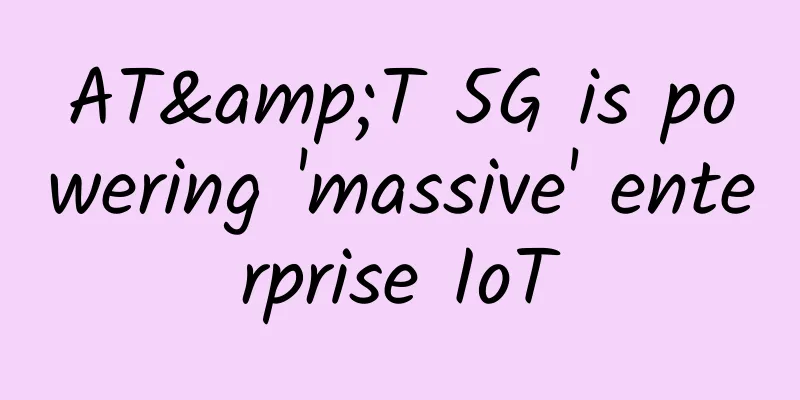AT&T 5G is powering 'massive' enterprise IoT

|
US-based telecom operators have been working on how their shiny new 5G networks can support enterprise Internet of Things (IoT) deployments to unlock the latent potential of wireless 5G to accelerate enterprise connectivity. Not to be outdone, AT&T has revealed that it is implementing sub-6 GHz 5G access for enterprise IoT deployments.
The Internet of Things is not a single technology, but an ecosystem of technologies, processes, and devices that promises to drive significant change in organizations. Together with sensors, gateways, integrated analytics, and reporting tools, the Internet of Things is all about leveraging data insights and automation to drive real-time business decisions. The touted connectivity enhancements of 5G, including blazing speeds and ultra-low latency, have put the standard name on the map alongside IoT applications for some time now. In fact, before the widespread rollout of 5G, U.S. carriers including AT&T have already been trying to use their wireless networks for IoT through technology based on LTE, the predecessor to 5G. In 2019, AT&T launched a nationwide narrowband IoT (NB-IoT) network on its LTE-M network, which is capable of supporting lower bandwidth requirements typically in the kilohertz range. Today, AT&T says its 4G LTE and low-power IoT cellular networks are currently managing millions of connected devices across industries and public safety, and are supported by managed services running on a platform provided by Cisco. In the not-too-distant past, networks like NB-IoT and Cat-M supported low-power smart devices like asset tracking sensors and smart meters because they had less complexity and didn’t consume as much data. Based on existing infrastructure and easier to deploy, NB-IoT and Cat-M technologies are estimated to account for 46% of all cellular IoT connections by 2026, according to Ericsson’s latest June Mobility Report. Now, AT&T and Cisco are opening up access to sub-6GHz 5G frequencies, with an announcement last week focused on customers of AT&T’s Control Center cloud IoT management platform. The Cisco Jasper-powered platform allows enterprises to gain full visibility into all IoT devices on their network and monitor data usage. The operator appears to be moving beyond its existing low-bandwidth market share toward more advanced future enterprise opportunities enabled by widespread 5G, with AT&T covering up to 251 million people with sub-6GHz 5G spectrum, and also leveraging appropriately deployable spectrum for 4G LTE as well. While officials see support for NB-IoT and LTE-M devices continuing into at least the next decade, AT&T points out how various industries will benefit from 5G's IoT advantages, with its increased bandwidth and lower latency powering the automotive and entertainment industries. On the production line, 5G can facilitate smart cameras to virtually monitor and identify defects on the production line in real time, thereby reducing waste. Meanwhile, AT&T earlier announced that it had reached its first 5G connected car deal with General Motors, and the operator welcomed faster media streaming and downloading experiences and other 5G benefits such as more entertainment, navigation and software updates. “Together with Cisco, we continue to help enterprises deploy IoT devices and applications faster and more securely, getting more value from the devices they use,” William Stovall, vice president of AT&T Mobility, IoT and 5G, said in a statement. “This is an important first step toward IoT connectivity at scale, which will ultimately create opportunities for enterprises to realize the full potential of IoT.” AT&T also said that for suppliers and users of mobile personal emergency devices for 5G IoT, "the faster response times provided by 5G can increase independence and a greater sense of security." AT&T will shut down its 3G network in February 2022, raising concerns about the nearly 6 million alert systems supported by U.S. cellular data networks, including wearable health IoT devices used to monitor the elderly or at-risk populations and alert emergency responders when needed. |
>>: "Interview Eight-part Essay" Network Volume 19
Recommend
Talking about China's communications industry: from "seven countries and eight systems" to the backbone of "China"
Salute to China's communications industry, Hu...
Ericsson signs 5G SA agreement with Spanish telecom operator Masmovil
According to foreign media reports, Swedish suppl...
How to share WiFi gracefully when the password is hard to reveal
"What's your home WiFi password?" T...
In the 5G era, where will the 2G-based temperature and humidity sensors go?
[[349400]] With the construction of 5G network ba...
Riverbed Launches Two New Visibility Solutions to Enable 360-degree View of Enterprise IT
[51CTO.com original article] Riverbed recently an...
5G private network spectrum allocation controversy: not black and white, but efficiency first
Recently, the French government announced that in...
What will 6G look like in the future?
[[389986]] At the recently concluded MWC Shanghai...
Strong partner ecosystem helps Denodo grow in Greater China
Beijing, March 10, 2021 - Denodo, a leader in dat...
Accelerating new infrastructure construction: Single-wavelength 200G backbone network is about to emerge, how far is 400G?
While the new infrastructure is accelerating the ...
How to make operation and maintenance get rid of the synonym of "busy, tired and hard"? It's simple, Donghua integrated operation and maintenance can easily do it!
[51CTO.com original article] Recently, the 23rd o...
Summarize various issues between wireless AP and AC of WiFi system
In wireless network construction, it is said that...
How to store IP addresses in MySQL efficiently?
A few days ago, a friend of mine went to an inter...
A 100% timeout murder caused by maxing out the bandwidth!
[[421757]] Verse: Do not advise others to do good...
Once together, now separated, 5G baseband will connect everything
2019 is the first year of 5G, but SoC and 5G base...
What is 5G RedCap, and can it save cellular IoT?
Regardless, in theory the latest version of the 5...





![[Black Friday] ITLDC: 40% off unlimited traffic VPS annual payment, 25% off dedicated server, 14 data centers in the United States/Singapore/Netherlands](/upload/images/67cabff1c82b9.webp)



